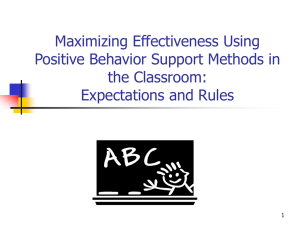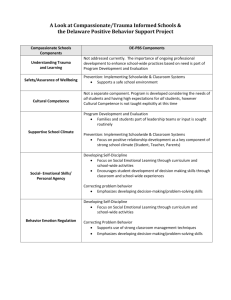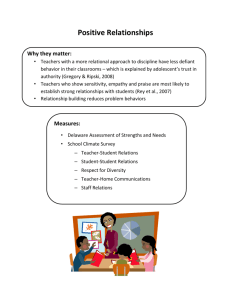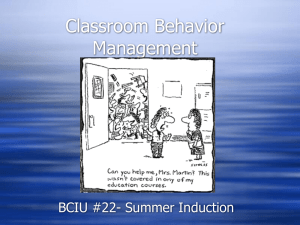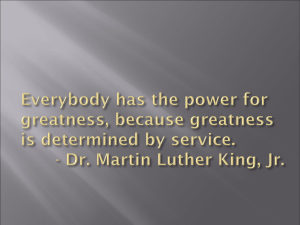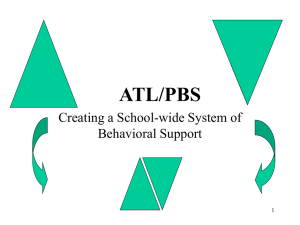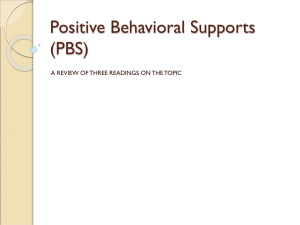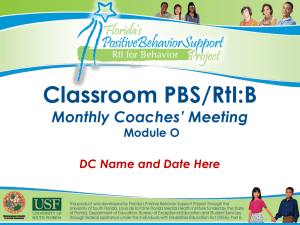DE-PBS Overview Presentation
advertisement
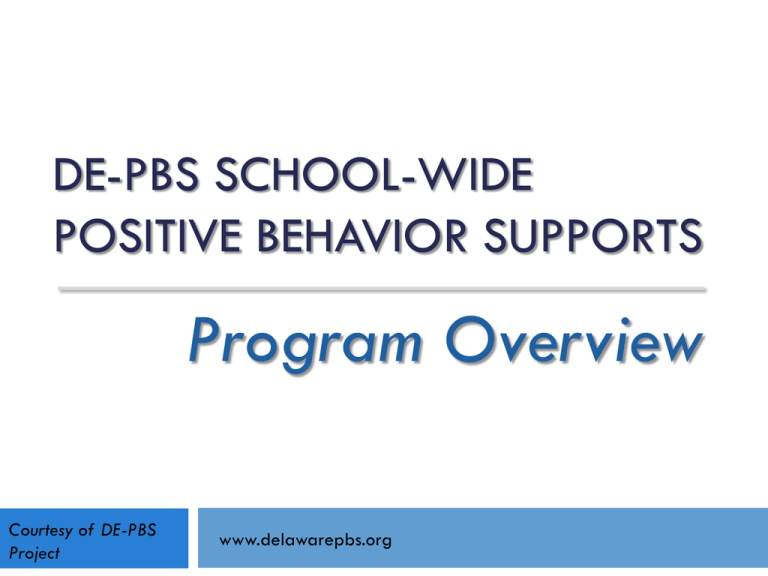
DE-PBS SCHOOL-WIDE POSITIVE BEHAVIOR SUPPORTS Program Overview Courtesy of DE-PBS Project www.delawarepbs.org What is School-wide Positive Behavior Support? A systems approach for establishing the social culture and individualized behavioral supports needed for schools to achieve both social and academic success for students Implemented with ALL students in a school Aims to prevent problem behaviors by teaching positive social expectations Emphasizes on data-based decision making Includes a continuum of intensive, individualized interventions Activity: Share DE-PBS Key Features List – discuss what stands out to staff, emphasize that DE-PBS is not simply about giving tickets/prizes/parties What does PBS look like in a school? • • • • • • >80% of students can tell you what is expected of them & can give behavioral examples because they have been taught, actively supervised, practiced, & acknowledged Positive adult-to-student interactions exceed negative Administrators are active participants Data & team-based action planning & implementation Function based behavior support is a foundation for addressing problem behavior Full continuum of behavior support is available to all students Common Myth about PBS The essence of PBS is not tickets, rewards, or parties DE-PBS is used to teach expected behavior, build positive relationships, and develop selfdiscipline in students Praise and rewards are simply a vehicle to achieving these goals and are certainly not the most important program component Why Use SW-PBS? Research has demonstrated: Reduction of problem behavior, discipline referrals, and suspensions Increase in math and reading scores Improvements in overall school climate (Lassen, Steele, & Sailor, 2006; Lewis et al., 2002; Luiselli, Putnam, and Sunderland, 2002; Todd et al., 1999) SCHOOL-WIDE POSITIVE BEHAVIOR SUPPORT ~5% ~15% Primary Prevention: School-/ClassroomWide Systems for All Students, Staff, & Settings ~80% of Students Tertiary Prevention: Specialized Individualized Systems for Students with High-Risk Behavior Secondary Prevention: Specialized Group Systems for Students with At-Risk Behavior Use of Data Why use data? Sets baseline to measure improvement Identifies need Guides intervention planning Measures effectiveness of our systems and practices What types of data can you use? Office Discipline Referral Data (ODR) Delaware School Climate Survey Disproportionality Data Staff & Student Attendance Retention, Dropout, Graduation Data Office Discipline Referral Data (ODR) “The Big Five” Average # of Referrals Per Day Per Month # of Referrals by Location # of Referrals by Behavior # of Referrals by Time of Day # of Referrals by Student (DDRT) Our School’s ODR Data Insert data overview here to review with staff Our School’s School Climate Data Insert data overview here to review with staff (if applicable) Including Students Insert information on how your school incorporates students into the SW-PBS program Our Student Kick-Off Time to share program information with the students to let them know: What school-wide PBS is Why we have the system in place What our school’s SWPBS system looks like Time for teaching expectations across settings Insert information about your student kickoff, such as the date, event information, and how teachers/staff will participate Including Families Insert information on how your school incorporates families into the SW-PBS program (such as presentation at open house, newsletter, information on website, etc.) School-wide Expectations Expectations are the umbrella for more specific rules. They are: Positively stated Simple and easy to remember Age appropriate Promote self-discipline, positive social and academic outcomes Our School-wide Expectations Insert your school’s expectations here Support staff to map out their classroom rules/routines under the umbrella of the SW Expectations Teaching Expectations We can no longer assume: • Students know the expectations/rules and appropriate ways to behave • Students will learn appropriate behaviors quickly and effectively without consistent practice and modeling We must assume: • Students will require different curricula, instructional modalities, etc… to learn appropriate behavior • We need to teach expectations/rules and appropriate behaviors as effectively as we teach academic skills School-Wide Behavioral Matrix Purposes: Defines the Expected Behaviors for Specific Settings: hallways, classrooms, gym, cafeteria, commons, bus loading, bathrooms, assemblies Creates the “Curriculum” that will guide the teaching of expected behaviors. Enhances communication among staff and between students and staff. Our School-Wide Behavioral Matrix Insert your school’s matrix here How do you teach behavioral expectations? • • • • Teach in the actual settings where behaviors are to occur Teach the words by demonstrating the actions using examples and non-examples. Model and practice to fluency Build a social culture that is predictable and focused on student success Respect Ourselves Respect Our Community Respect Our Environment Our Teaching Plan Insert information about your school’s lesson plans (where to find them, expectations on teaching them, etc.) Acknowledging Students When to use: Recognizing desired behavior is a strategy to prevent behavior problems Teach new behavior Strengthen replacement behaviors that compete with habitual undesirable behavior Create frequent positive interactions between staff and students Acknowledging Students Rewards are effective when: Used to build new skills or sustain desired skills Delivered for specific behavior on a contingent basis Gradually faded over time Tied to specific behaviors Delivered soon after the behavior Age appropriate (actually valued by student) Delivered frequently Gradually faded away Acknowledging Students Because PBS is about developing positive relationships, rewards should not be costly The things that students want are often intangible i.e., having lunch with a favorite teacher, being a helper in another classroom, or having a positive visit with the principal Try free and low-cost rewards before using more expensive options Visit this list containing 100 ideas for free rewards Acknowledging Students Insert information about your school’s acknowledgement system (ticket system, school store, etc.) and how teachers can acknowledge students without tangible items (i.e. praise) Share Effective Use of Praise and Rewards Developing Self-Discipline How children behave in your absence is more important than how they behave in your presence or when punishment and rewards are not highly salient A goal of PBS is to develop the following skills in students: Responsible decision making Self-management of emotions and behavior Relationship skills Social awareness Self-awareness Developing Self-Discipline How can PBS develop self-discipline in students? When praising students, encourage them to think about how their actions made others feel View correction as an opportunity to develop problem solving and decision making skills in student Participate in service learning, buddy program, or mentoring opportunities Teach lessons intended to help develop social and emotional competencies in students Involve students in school-wide decision-making Role of Teachers and Staff Teaching expectations Supporting students to meet expectations Acknowledging students meeting expectations System for responding to problem behaviors Fostering students’ social and emotional competencies Tailor this page to indicate how teachers/staff are expected to implement the program
